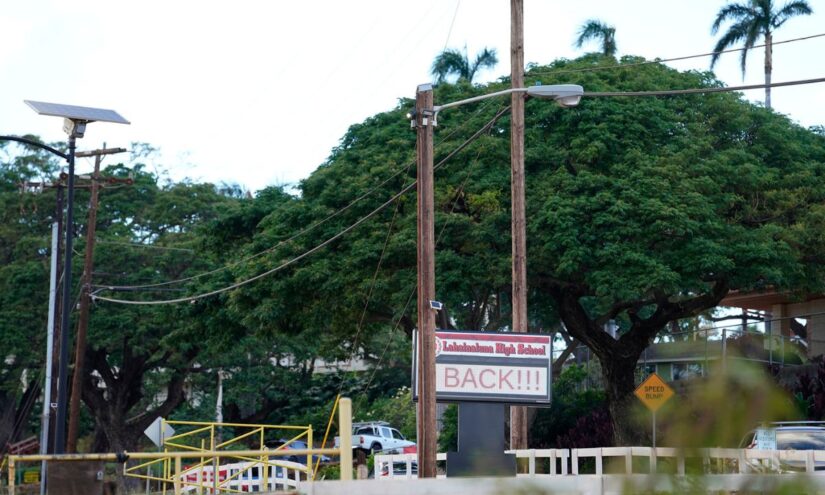During this summer, a team of students from MIT embarked on a journey to the sou …
Lahaina Teachers Advocate for Increased Support in West Maui Schools
Jennifer Livingstone

Concerns about teacher retention and student safety are on the minds of families and school leaders in West Maui as the academic year concludes amid deadly wildfires.
During the past year, Lahaina’s four public schools have seen a decline in enrollment by approximately 1,000 students, with some families hesitating to send their children back due to worries about emergency readiness and the mental health impact of being near the fire-affected area.
Apart from the diminishing student count, the teachers’ union anticipates recruitment and retention challenges for Lahaina educators next year. Teachers have expressed dissatisfaction with the Hawaii Department of Education’s lack of support post-fires, particularly the absence of extra leave and flexibility for those needing to relocate from West Maui.
In the upcoming school year, Lahaina teachers are advocating for increased counseling services and mental health support for students, while the union is mobilizing to pressure the superintendent and Hawaii Board of Education to address educators’ demands, such as salary hikes and enhanced paid leave benefits for Lahaina teachers.
Lahaina was previously classified as a hard-to-staff location in 2020 due to numerous teacher vacancies and emergency recruitments in the region.
“The situation is incredibly stressful for many individuals,” noted Jarrett Chapin, an English teacher at Lahainaluna High.
Recruitment Obstacles
Prior to the wildfires, hiring teachers in Lahaina was already challenging due to housing shortages and high living costs, notwithstanding the annual $5,000 bonus provided to Lahaina teachers since 2020 due to severe staffing deficits.
The teachers’ union is requesting DOE to raise the annual bonus to $8,000 in response to Maui’s escalating living expenses. While the department initially declined the request in March, Superintendent Keith Hayashi recently signaled a willingness to consider the increment.
Hayashi mentioned that DOE has been offering mental health support to students and educators through various means, including staff training and collaborations with the Department of Health.
The department is currently recruiting for teaching positions at different schools in Maui, with plans to maintain stable funding for Lahaina schools in the upcoming year, though hiring specifics due to reduced student enrollment remain unspecified.
In Wailuku, Iao Intermediate is seeking to hire seven teachers for the next academic year, with Wailuku Elementary also looking for four new teachers. Similar staffing needs are prevalent in schools across Maui.
Andrea Eshelman, deputy director of HSTA, expressed concerns over potential teacher departures at the year’s end, attributing this to severe housing shortages in West Maui and DOE’s inadequate support for faculty post-wildfires.
Responding to these challenges, HSTA has initiated a petition urging DOE to establish a leave program allowing teachers to donate sick days to Maui educators affected by the fires, gaining support from numerous union members and teachers advocating for additional assistance at the BOE meeting.
The proposed leave bank would enable Maui teachers to take paid time off following the fire’s aftermath.
Sharing her ordeal, Lahainaluna teacher Michelle Abad Brummel, who lost her home in the fires, emphasized the financial burden of temporary relocation and expressed disappointment in DOE’s response.
Commenting on the situation, teacher Ashley Olson stressed the need for enhanced mental health support for educators and students, urging DOE to actively engage in offering professional assistance consistently.
Following teacher concerns, BOE members acknowledged the issues and pledged increased support in the upcoming school year.
“We hear and understand your demands,” affirmed board member Makana McClellan.
Adapting to Change
Prior to the wildfires, Lahaina’s four public schools catered to around 3,000 students. However, a significant drop in combined enrollment to approximately 2,000 students is anticipated for the next academic year.
DOE reported that most students who hadn’t returned to Lahaina campuses had enrolled in other Maui public schools, with a minority opting for out-of-state or non-DOE Hawaii schools.
Rita McClintock, a parent from Kaanapali, has decided against sending her daughter back to Lahaina Intermediate, choosing Hawaii Technology Academy instead since the hybrid classes commenced not long after the fires.
Initially operating from a church, HTA moved to a new location in March, aiming to provide a stable education environment for families impacted by the fires.
While trusting DOE’s safety measures, McClintock remained concerned about emergency preparedness in case of future fires near the schools.
Similarly, Miriam Keo, whose children attended Lahaina Intermediate’s Hawaiian immersion program before the fires, is considering future schooling options given uncertainties about student safety protocols.
HTA’s Lahaina campus is expecting approximately 60% student return in the next academic year, with many families relocating from West Maui causing commuting challenges.
Focusing on students’ mental well-being, HTA has emphasized recovery and imaginative projects, emphasizing the school’s commitment to ensuring a positive end-of-year experience.
While some families have settled on alternative educational paths, others await decisions on campus locations and safety protocols for the upcoming school year.
“Our primary goal is to ensure our students leave satisfied with their school year experiences,” shared Ginny Kamohalii-Dew, HTA’s community coordinator.
Reflecting on Lahaina’s recovery and the shifting educational landscape, families seek stability and support in navigating the aftermath of the devastating fires.

